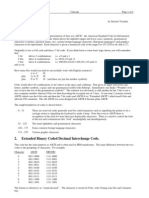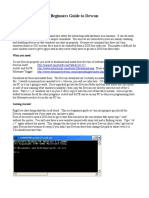Notes On JAVA 10.2005.6: The String Data Type: Constructor Input
Uploaded by
Jonas SingboNotes On JAVA 10.2005.6: The String Data Type: Constructor Input
Uploaded by
Jonas SingboNotes on JAVA 10.2005.
6: The String Data Type
NOTE: Strings are objects, not a basic (primitive) data type! Therefore you have to treat
them differently! Consult the API (Help menu) for all the different methods available with the String class! Strings have a limit of 255 characters! If they get too large, everything from the 256th character onwards is truncated (cut, lost). Constructor . Input String s = new String (); String s = Stdin.readLine (); creates a new string called s reads a string s from keyboard.
Output Example:
System.out.println (s); prints string s to screen. System.out.println ("Hello World"); will print Hello World to the screen. int len = s.length (); returns an integer
The length method
gives an integer representing the number of characters in the string. Example: s = "Hello World"; int len = s.length (); will return 11. The indexOf method int pos = s.indexOf (, ); returns an integer
searches for the first occurrence of the comma-space combination in the mainstring and returns the position of the first character of the first occurrence of the substring in the mainstring (an integer). If not found, the function returns 0. Example: s = "Size doesnt matter"; int pos = s.indexOf ("do"); will return a 5. The substring method s = s.subString (start, end); returns a string
copies a substring from the mainstring, starting at start (inclusive) to end (exclusive). If start is greater than end, an empty string will be returned. Example: s = "This is copied"; String ss = s.subString (8, 14); will assign the value copied to ss. The concat method s = s.concat (ss); returns a string
combines the strings s and ss, the latter being added to the back of s. It concatenates ss to the end of s. Example: s = "blah"; s = s.concat ("blah"); will assign the value blahblah to s. Note: This can also be written as: s = s + "blah"; OR (different order) s = "blah" + s; OR s = "blah" + "blah" + "blah"; OR s = s + ss; etc. The equals method boolean e = s.equals (ss); returns a boolean
indicates whether the strings s and ss are absolutely identical. Example: if (s.equals ("yes")) after s was entered from keyboard will return true (i.e. let the program proceed) if and only if yes was entered. The equalsIgnoreCase method boolean e = s.equalsIgnoreCase (ss); returns a boolean
indicates whether the strings s and ss are identical in spelling but not necessarily in case. Example: if (s.equalsIgnoreCase ("yes")) after s was entered from keyboard will return true for yes, Yes or YES.
Notes on JAVA: Strings The charAt method char a = s.charAt (int);
Page 2 of 2 returns a character
returns the character at a specific position from a string (NB: the int may NOT be bigger than the index of the last letter!) so that the characters can be accessed individually by means of the index, e.g. to print them backwards, one below the other, etc. Example: s = "Size doesnt matter"; char first = s.charAt (0); will return S, and char x = s.charAt (9); will return n. The toUpperCase method String uc = s.toUpperCase (); returns a String
returns a string where all characters are in upper case. Example: s = "Hello World"; uc = s.toUpperCase (); will return "HELLO WORLD". The toLowerCase method String lc = s.toLowerCase (); returns a String
returns a string where all characters are in lower case. Example: s = "Hello World"; lc = s.toLowerCase (); will return "hello world".
EXERCISES:
1. Write a program that will read in your name (a String) and then print the name getting shorter and shorter. getting longer and longer, e.g. P Pe Pet Pete Peter 2. Write a program that will read in your name (a String) and then print it backwards. downwards. as a square, e.g. OR (more advanced) as a diamond, e.g. P e t e r e e t t e e r e t e P J o o h n h o o J 3. Write a program that will read in your name (a String), convert all letters to lower case, sort the letters and print it, e.g. Peter will become eeprt 4. Write a program that will read in a sentence (a String) and then print each word on a new line, e.g. This is a sentence h h n
_________________________________________________
mb
You might also like
- Java Programming 1: Strings and CharactersNo ratings yetJava Programming 1: Strings and Characters18 pages
- Building Java Programs: Lecture 4-3: Strings CharNo ratings yetBuilding Java Programs: Lecture 4-3: Strings Char36 pages
- Modern Programming Tools and Techniques-I: StringNo ratings yetModern Programming Tools and Techniques-I: String26 pages
- Dokumen - Tips 11 String and String Builder JavaNo ratings yetDokumen - Tips 11 String and String Builder Java33 pages
- Strings (Icse) : I) String Ii) StringbufferNo ratings yetStrings (Icse) : I) String Ii) Stringbuffer4 pages
- String Handling: String: It Is A Final Class in Java - Lang PackageNo ratings yetString Handling: String: It Is A Final Class in Java - Lang Package12 pages
- JAVA - MCA 2021 - UNIT 3 - Student - 230926 - 204632No ratings yetJAVA - MCA 2021 - UNIT 3 - Student - 230926 - 204632193 pages
- Java Strings: Creating Strings String MethodsNo ratings yetJava Strings: Creating Strings String Methods19 pages
- 7.4.1.11 Lab - Configure A NIC To Use DHCP in WindowsNo ratings yet7.4.1.11 Lab - Configure A NIC To Use DHCP in Windows6 pages
- Notes On JAVA 10.2005.4: Revision of Loops:: You Can Remember These Three Principles With The Letters I-T-CNo ratings yetNotes On JAVA 10.2005.4: Revision of Loops:: You Can Remember These Three Principles With The Letters I-T-C2 pages
- Notes On JAVA 10.2005.3: Syntax of CommandsNo ratings yetNotes On JAVA 10.2005.3: Syntax of Commands3 pages
- Face Recognition Techniques: A Review: Rajeshwar Dass, Ritu Rani, Dharmender KumarNo ratings yetFace Recognition Techniques: A Review: Rajeshwar Dass, Ritu Rani, Dharmender Kumar9 pages
- Trygg-Hansa Dumpmaster: Quick PresentationNo ratings yetTrygg-Hansa Dumpmaster: Quick Presentation65 pages
- Steno Cum-Typist, Junior Assistant - Cum-Typist, Junior Assistant & Technician inNo ratings yetSteno Cum-Typist, Junior Assistant - Cum-Typist, Junior Assistant & Technician in1 page
- CMP E1FX Flameproof ATEX Cable Glands For Galvanised Steel Wire Braided Cables (GSWB)No ratings yetCMP E1FX Flameproof ATEX Cable Glands For Galvanised Steel Wire Braided Cables (GSWB)1 page
- UK Visa Check List: More Than One Month Before The Date of Your ApplicationNo ratings yetUK Visa Check List: More Than One Month Before The Date of Your Application3 pages
- Export and Save Worksheets As New Workbook With VBA CodeNo ratings yetExport and Save Worksheets As New Workbook With VBA Code5 pages
- Test Cases Test Case For Print (Table) : Test Case Action Input Value Expected Results Actual Results Pass/FailNo ratings yetTest Cases Test Case For Print (Table) : Test Case Action Input Value Expected Results Actual Results Pass/Fail5 pages





































































































